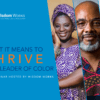I have to admit that I didn’t really care who Tiger Woods was until lately. Sure, I was aware he was an iconic sports celebrity, but for me, golf’s television appeal is right up there with watching action films on knitting.
So I was as surprised as anyone when I read recently about Tiger’s self-imposed reinvention. Yes, I’m a little behind the times on this stuff—but at least enough time has passed to put his bold move in perspective. When he won the PGA Championship in 2007 he was at the top of his game, largely due to a swing that analysts said was near-perfect. Right about then he decided to reinvent that same golf swing. Flash forward to today: his instinct served him well: he is a record-breaking machine, the face of modern golf, and one of the world’s highest paid athletes.
No, I haven’t turned my blog into a sports column. What inspired me about Tiger’s voluntary transformation was that he chose to do it when most of us would be resting on our laurels and thinking of creative ways to spend all our winnings. I suddenly realized how Tiger was not an overblown celebrity, but actually a master of learning in action. Tiger’s attitude at that moment in his career set a new standard for every one of us high-achieving types. I translate it to this axiom: lasting success demands the relentless ability to learn.
What does it take to be at your peak and still choose to learn, grow, and challenge old habits? It’s uncommon, to be sure, but that’s one of the very natures of leadership. Frankly, it’s much easier to go with the unexamined flow of life, to simply accept and exploit your existing talents and coast as far as they’ll take you.
Sometimes that “coasting” is just what the doctor ordered—we can’t always be reinventing or we would never get to enjoy the fruits of our inventions. Plus it’s simply egotistical to think that all progress rests on our own efforts—sometimes we must ease up to let others do their part toward collaborative progress. But the leader gene won’t allow us to coast for long.
Athletes do repetitive drills to prepare for competition. Musicians rehearse before a concert. Surgeons (thankfully) engage in dry-runs prior to the actual heart operation. In all of these enterprises, learning is designed into the job of achieving ever-higher levels of strength, precision, and performance.
Oddly enough, the role of leadership is typically jam-packed with soaring expectations yet empty of learning strategies to help get there. All too often as leaders we demote learning on our priority lists—it will happen “when I have time.” For me, that’s the equivalent of a death sentence to sustainable high performance.
Think about it: as leaders did we really think we could stop learning our trades, our crafts, the art and science of what we do? Did we really think the world was going to stand still, the competition was going to step aside, and we could coast to some imaginary finish line?
I for one am willing to step up and say it’s high time to reinvent my own skills. I’m curious: are you ready to say the same? If so, here’s a start: What strengths could you be using with greater impact? How might you uncover the blindspots in your leadership style? What new habits or skills do you need to learn to move toward your grander goals? It takes courage (read: guts, nerve, chutzpah) to ask these kinds of questions like Tiger did: at the top of your game, rather than waiting till you go stale.
Our world and our organizations need leaders to be consummate learners today more than ever. Of course, it’s not only about making a positive difference “out there;” learning brings about positive change in our own day-to-day lives.
While I still think golf on TV is like watching paint dry, I do appreciate the lesson of Tiger’s transformation. Here’s hoping you find similar opportunities for learning and transformation in your own life as a leader.
Photo by Keith Allison






Hi Renee,
Read your interesting article about Tiger. I totally agree. He is a role model for all of us. Like you I am not much for the golf. But I did watch the Masters this year on TV and enjoyed it very much. So much more that goes into it than the physical movements. Fascinating.
Trust you are well and I see you are busy.
Best regards,
Runa Bouius
Glad you like the blog, Runa!
Are there any particular topics you’d like to see me cover in this blog in the future? I’m interested in your input. Thanks so much.
The Tiger Woods situation Dr. Moorefield describes can be described in the words of John Wooden, a hall of fame basketball coach: “It’s what you learn after you know it all that counts.” I like this idea very much but to dive into it just a little bit further, it would seem to me there are two relevant parts to this trait in great leaders and learners.
The first is humility. So many people achieve a high level of aptitude at what ever it is they pursue and then become stagnant. The humility to overcome your own success is a crucial trait of those, like Mr. Woods, who would be truly great leaders. Not long ago, I read a memo called “Strengthening GM’s Organizational Capacity” written in the late 1980’s by a man named Elmer Johnson who was purportedly being groomed for the CEO position at the time. The memo was a plea to address the issues that had propagated in GM’s culture that he felt were hindering their prospects for future success. He describes a culture fraught with lassitude and an inability to execute created by more than 50 years of dominance in the auto industry. GM is a perfect example of what not to do. After so long on top of the game, the organization saw itself as “entitled” to success, regardless of how it actually conducted its business operations. We all know where that has gotten them as of late. Incidentally, Mr. Johnson left GM not long after his memo was written but his predictions are eerily accurate given the events of the past few months.
The second piece of the puzzle is the idea of being joyfully incomplete. Have you ever taken up a new hobby just because you were very good at something you enjoyed? After a lifetime of alpine skiing in places that most people would think are insane, I recently became a full-time telemark skier. Wow is it HARD! But I enjoy that I am actively learning and feeling the joy of progress with something I love so much. The milestones are memorable, and I just love that sense of accomplishment when I “get” some new little piece of the puzzle. Always remembering to be joyfully incomplete makes learning so much FUN, and is a crucial part of not only becoming, but remaining a leader of others.
Thank you Dr. Moorefield, I return to this blog often to read the articles you have posted here. It is one of the tools I intend to use for a long time to always be learning something new and expanding my own horizons.
Regards,
Nathan Singsen
You make two really good points about what it takes to learn, Nathan.
Thanks! For me, “humility” is the simple (yet not always easy to do) ability to say “I don’t know” (and mean it!) Without true humility, learning something totally new or improving on current knowledge and skills cannot occur. Ironically, our learning becomes prevented due to all the things we believe we already know.
I particularly love your point about being “joyfully incomplete.” One gift of learning is to know that we are “incomplete” (in that we cannot know everything … that’s where humility comes to play), yet to also know that we can lean into that “incompleteness” (that “unknown”) with a sense of joy and experimentation. Then, both “what” we learn and “how” we learn becomes gratifying.
This attitude toward learning is especially relevant now, as we — individually and collectively — lean into the unknowns of our world; as jobs, economies, business performance and, truthfully, our lives are in incredible flux, we have an opportunity to approach this flux with optimism, creativity and a determination to create something meaningful, positive and sustainable.
As a global society, we are at a critical juncture of life and work, and we can choose to use this juncture to evolve our ways of relating with one another, with ourselves and with the planet. We can choose to learn something new about what it means to be human.